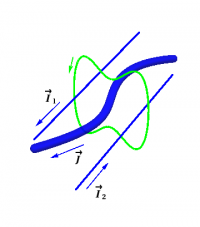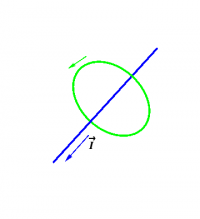Ampère's Law
Ampére's Law says that a geometric property of the magnetic field (namely the circulation around a particular closed loop) is the same as the current enclosed by that same loop (times $\mu_0$ in the system of units that we are using): \begin{eqnarray*} \oint\limits_{\rm loop} \BB \cdot d\rr = \mu_0 \, I_{\rm enclosed} \end{eqnarray*}
This situation is illustrated in Figure 1, which shows an arbitrary oriented loop, through which two thin wires carry currents $\II_1$ and $\II_2$, and a third wire with larger cross-section having volume current density $\JJ$. In this case, $I_{\hbox{enclosed}}$ would be the total current flowing through any surface bounded by the given loop, and would therefore be the result of adding the sum of the components of the currents in the two thin wires perpendicular to the surface to the flux of $\JJ$ across the surface.
Ampére's law is a physically observed law which is true for any static current distribution, discrete or continuous. The closed loop that is referred to in the law is not a physical loop, rather it is any abstract closed curve that you can imagine. There is no problem with the law if there is also current flowing outside the loop. Such sources will contribute to the magnetic field, but when you sum up the circulation around the entire loop, the contributions from current flowing outside the surface will cancel. Notice that a consequence of Ampére's law is that the circulation of the magnetic field around two different loops is the same if they enclose exactly the same current distribution.
As an example, consider an infinite wire along the $z$-axis carrying a uniform current $\II$, and take the loop to be a circle of radius $r$ in the $xy$-plane, centered at the origin, as shown in Figure 2. The magnetic field due to this current is \begin{eqnarray*} \BB = \frac{\mu_0}{2\pi} \frac{I}{r}\, \phat \end{eqnarray*} and the vector differential along a circle is \begin{eqnarray*} d\rr = r\,d\phi\,\phat \end{eqnarray*} Thus, the circulation is given by \begin{eqnarray*} \Int_{\hbox{circle}} \BB \cdot d\rr &=& \Int_{\hbox{circle}} \frac{\mu_0}{2\pi} \frac{I\,\phat}{r} \cdot \phat\,r\,d\phi \\ &=& \frac{\mu_0}{2\pi} \frac{I}{r} \times (\hbox{circumference}) \\ &=& \mu_0\,I \end{eqnarray*} as claimed. (Why was it ok to replace the integral with the circumference?) Note that the value of this integral does not depend on the radius $r$ of the circular loop.

